
Do you have a question about the Rockwell Automation Allen-Bradley CompactLogix 5370 and is the answer not in the manual?
| Power Supply | 24V DC |
|---|---|
| Communication Ports | EtherNet/IP, USB |
| Programming Software | Studio 5000 |
| Operating Temperature | 0°C to 60°C (32°F to 140°F) |
| Certifications | CE |
| Memory | Varies by model (e.g., 512KB, 750KB, 1.5MB, 3MB) |
Details modifications made in the current manual revision.
Lists and defines abbreviations used throughout the document.
Information on accessing software and firmware compatibility resources.
Lists related publications and resources for further information.
Details the hardware components that make up a typical control system.
Describes the capabilities and specifications of different controller models.
Explains the electronic keying feature for device compatibility and error prevention.
Provides visual examples of typical system setups using various network topologies.
Details environmental and enclosure requirements for safe and proper installation.
Information on hazardous location approvals and safety precautions.
Guidelines for use in potentially explosive atmospheres according to European standards.
Pre-installation considerations and prerequisites for the L1 controller.
Lists the components included with the controller.
Outlines the main steps involved in installing the controller.
Instructions for installing or reinstalling the SD card.
Covers mounting and grounding the controller system.
Details how to mount the controller system on a DIN rail or panel.
Provides instructions for properly grounding the controller system.
Step-by-step guide to physically installing the controller onto the mounting base.
Instructions for removing and reinstalling the terminal block.
Details how to connect the power supply to the controller.
Explains how to establish a connection using a USB cable.
Guides on connecting the controller to an EtherNet/IP network.
Environmental and enclosure requirements for the L2 controller.
Approval information for hazardous locations in North America.
Guidelines for use in potentially explosive atmospheres in Europe.
Pre-installation considerations for the L2 controller.
Lists components included with the L2 controller.
Overview of the installation steps for the L2 controller.
Steps for installing the SD card in the L2 controller.
Covers installing and mounting the L2 controller system.
Details on mounting the L2 controller system on a DIN rail or panel.
Guidelines for spacing around the L2 controller system.
Dimensional information for the L2 controller and system.
Proper grounding procedures for the L2 controller system.
Physical installation steps for the L2 controller.
Procedures for managing the terminal block on the L2 controller.
Instructions for wiring the terminal block of the L2 controller.
Specifications for wire size and screw torque for the L2 controller.
How to connect power to the L2 controller system.
Steps to connect the L2 controller using a USB cable.
Guide to connecting the L2 controller to an EtherNet/IP network.
Environmental and enclosure requirements for the L3 controller.
Approval information for hazardous locations in North America.
Guidelines for use in potentially explosive atmospheres in Europe.
Pre-installation considerations for the L3 controller.
Lists components included with the L3 controller.
Overview of the installation steps for the L3 controller.
Instructions for installing the SD card in the L3 controller.
Covers installing and mounting the L3 controller system.
Steps for assembling the L3 control system components.
Details on mounting the L3 controller system on a DIN rail or panel.
Guidelines for spacing around the L3 controller system.
Dimensional information for the L3 controller and system.
Explains power supply distance ratings for L3 system modules.
Proper grounding procedures for the L3 controller system.
Instructions for mounting the controller onto a panel.
Instructions for mounting the controller onto a DIN rail.
How to connect power to the L3 control system.
Steps to connect the L3 controller using a USB cable.
Guide to connecting the L3 controller to an EtherNet/IP network.
Lists required software versions for controller installation.
Guides on how to assign an IP address to a controller.
Instructions for using a BOOTP server to set the controller's IP address.
Instructions for using a DHCP server to set the controller's IP address.
Steps for setting the controller's IP address using RSLinx software.
Guide to setting the controller's IP address via Logix Designer.
How to use an SD card to set the controller's IP address.
Procedures for changing an existing IP address of the controller.
Steps to change the network IP address using RSLinx Classic.
Steps to change the network IP address using Logix Designer.
How to change the network IP address using an SD card.
Instructions for downloading the latest controller firmware.
Guide to loading firmware using ControlFLASH software.
Instructions for loading firmware using the AutoFlash utility.
How to load firmware from an SD card.
Explains how to select the controller's operating mode (RUN, PROG, REM).
Details on communication over EtherNet/IP networks.
Lists software required for EtherNet/IP communication.
Features and capabilities of EtherNet/IP networking on the controllers.
Explains Ethernet node limitations and counting rules.
Lists devices that count towards the Ethernet node limit.
Lists devices that do not count towards the Ethernet node limit.
Describes different EtherNet/IP network topologies (DLR, Linear, Star).
Details the Device-level Ring (DLR) network topology.
Explains the linear network topology for EtherNet/IP.
Describes the star network topology for EtherNet/IP.
How to use socket interfaces for communication with non-EtherNet/IP devices.
Explains Quality of Service (QoS) and its impact on I/O module connections.
Information on establishing connections over EtherNet/IP.
Covers communication using DeviceNet networks.
Lists software required for DeviceNet communication.
Details the 1769-SDN DeviceNet scanner functionality.
Explains power supply distance ratings for DeviceNet scanners.
Specifics for using DeviceNet scanners with L2 controllers.
Specifics for using DeviceNet scanners with L3 controllers.
Information on current capacity for L3 control systems.
Options for selecting I/O modules for L1 controllers.
How to connect field power to I/O devices for L1 controllers.
Details on the embedded I/O modules for L1 controllers.
Wiring information for embedded analog and digital input points.
Wiring information for embedded digital output points.
Information on using 1734 POINT I/O modules as local expansion.
How to use distributed I/O over EtherNet/IP for L1 controllers.
Procedure to validate the layout of I/O modules.
Guidance on setting RPI values for I/O modules.
Understanding faults related to RPI settings.
Information on power requirements for the system.
Guidelines for physically placing I/O modules.
How to configure and use event tasks for embedded input points.
Options for selecting I/O modules for L2 controllers.
Details on the embedded I/O modules for L2 controllers.
Information on embedded digital I/O points and their wiring.
Details on embedded analog I/O points and their configurations.
Explains how channel update times are determined for analog inputs.
Information on CJC update times for thermocouple inputs.
How open circuit detection affects update times.
Guidance on setting RPI values for L2 I/O modules.
Understanding faults related to RPI settings for L2 controllers.
Power supply capabilities for L2 controllers.
Explains power supply distance ratings for L2 controller modules.
Steps to configure local I/O modules for L2 controllers.
Instructions for configuring embedded I/O modules on L2 controllers.
Steps to add and configure Compact I/O modules as local expansion.
Common configuration options for Compact I/O modules.
Describes different I/O connection types.
Steps to configure distributed I/O over EtherNet/IP for L2 controllers.
Steps to configure distributed I/O over DeviceNet for L2 controllers.
Methods for monitoring I/O modules on L2 controllers.
Information on end cap detection and module faults.
Options for selecting I/O modules for L3 controllers.
Information on using Compact I/O modules as local expansion.
Steps to install local expansion modules for L3 controllers.
Instructions for wiring local expansion modules.
How to use distributed I/O over EtherNet/IP for L3 controllers.
How to use distributed I/O over DeviceNet for L3 controllers.
Procedure to validate the layout of I/O modules.
Guidance on setting RPI values for L3 I/O modules.
Understanding faults related to RPI settings for L3 controllers.
How to calculate system power consumption for L3 controllers.
Steps to calculate power consumption in a single bank.
Steps to calculate power consumption in an additional bank.
Guidelines for physically placing I/O modules in L3 systems.
Validation requirements for the local bank design.
Requirements for designing additional banks in the system.
Explains power supply distance ratings for L3 controller modules.
Steps to add and configure Compact I/O modules for L3 controllers.
Steps to configure distributed I/O over EtherNet/IP for L3 controllers.
Steps to configure distributed I/O over DeviceNet for L3 controllers.
Methods for monitoring I/O modules on L3 controllers.
Overview of the components that make up a control application.
Explains how tasks are used for scheduling and prioritizing program execution.
How programs are used to group data and logic within a task.
Differentiates between scheduled and unscheduled programs.
Defines routines as sets of logic instructions for executable code.
How to use tags (alphanumeric names) to address data in Logix5000 controllers.
Feature for defining additional information like limits and units for components.
How to access defined extended properties within the logic.
Overview of programming languages supported by the controller.
How to create and use reusable sets of instructions (Add-On Instructions).
How to access module status information using the MODULE object.
Steps to create custom Add-On Instructions.
Using GSV/SSV instructions to monitor controller data.
How to monitor I/O connections and detect communication timeouts.
Example using GSV to identify I/O timeouts.
How to get fault codes for timed-out I/O modules.
Configuring I/O connection errors to trigger the Controller Fault Handler.
Explains the controller's time slice for service communication.
Steps to configure the system overhead time slice.
Accessing and modifying sample projects.
Information on supported motion axes for integrated motion.
Explanation of the AXIS_VIRTUAL axis configuration.
Explanation of the AXIS_CIP_DRIVE axis for physical drives.
Types of configurations supported for motion axes.
Limits on the number of position loop-configured drives.
Specific limits for position loop drives.
Importance and function of time synchronization (CIP Sync) for motion.
Steps to configure integrated motion applications.
How to enable time synchronization for motion control.
Steps to add a drive to the integrated motion project.
Information on system scalability for integrated motion.
Options for loading projects from an SD card.
Steps to store a project onto the SD card.
Steps to load a project from the SD card.
How Logix Designer indicates fault conditions.
Explains warning signals indicating connection issues.
How status line messages indicate module faults.
How tag editor reports general module faults.
How to determine fault types using Module Properties.
Explains the meaning of controller status indicators.
Details the RUN status indicator meanings.
Details the FORCE status indicator meanings.
Details the I/O status indicator meanings.
Details the OK status indicator meanings.
Details the Ethernet Network Status indicator meanings.
Details the Ethernet Link Status indicator meanings.
Details the SD Card Activity indicator meanings.
Compares CompactLogix L1 Series A and B controllers.
Details power requirements and considerations for L1 controllers.
Specifics for embedded DC inputs on L1 controllers.
Firmware compatibility between Series A and B controllers.
Physical dimensions of the controllers.
Wiring diagrams for power supplies for Series B and A controllers.
Illustrative examples of controller replacement and firmware updates.
Example procedure for replacing a controller and updating firmware.
Example procedure for physically replacing the controller.
How to connect power to the Series A L1 controller.
Connecting field power to I/O devices for Series A L1 controllers.
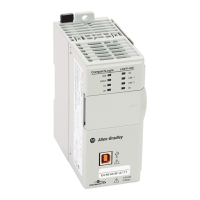
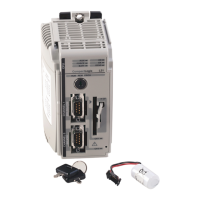

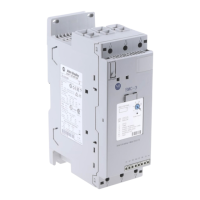
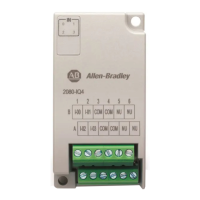
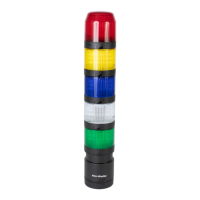

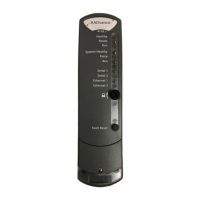
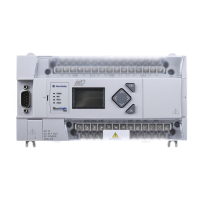
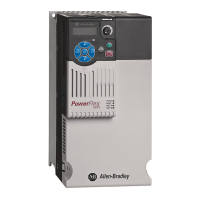
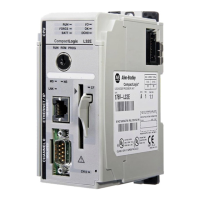

